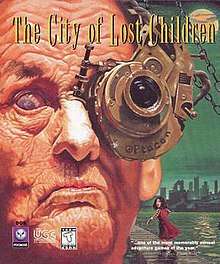The City of Lost Children (video game)
The City of Lost Children[lower-alpha 1] is an adventure game developed and published by Psygnosis in 1997. It based on the film of the same title and was released in the United States and in parts of Europe for the PlayStation console first and then the PC. The PC version is a straight port of the PlayStation version.[2] Players take on the role of the film character Miette.[3]
| The City of Lost Children | |
|---|---|
 North American DOS cover art | |
| Developer(s) | Psygnosis |
| Publisher(s) | Psygnosis PlayStation
|
| Director(s) | Denis Friedman |
| Producer(s) | Carole Faure |
| Designer(s) | Jésus Martinez Laurent Cluzel Philippe Tesson |
| Programmer(s) | Eric Metens Jean-Michel Vourgère |
| Artist(s) | Jean-Christophe Drouin Lionel Caillaud Nicolas Seck |
| Writer(s) | Nicolas Meylaender |
| Composer(s) | Francis Gorgé |
| Platform(s) | MS-DOS, PlayStation |
| Release | MS-DOS PlayStation |
| Genre(s) | Adventure |
| Mode(s) | Single-player |
Reception
| Reception | ||||||||||||||||||||||||||||
|---|---|---|---|---|---|---|---|---|---|---|---|---|---|---|---|---|---|---|---|---|---|---|---|---|---|---|---|---|
| ||||||||||||||||||||||||||||
On GameRankings the PC version holds a score of 60% based on three reviews,[4] while the PlayStation version holds a score of 54.50% based on four reviews.[5]
The game received mediocre reviews. Reviewers generally remarked that the graphics are stunningly beautiful and atmospheric,[9][11][12][2][16] but criticized the excessive difficulty of finding objects[9][11][12][2][16] and the slow pace.[9][11][12][16] A Next Generation critic explained, "To pick up an item, you must stand directly on top of it, a problem when most of the important objects aren't out in plain sight. You'll find yourself looking in every nook and cranny just to make sure you didn't miss something. Even then, the vast majority of items are found almost by accident ..."[2] Josh Smith of GameSpot further remarked, "The game's puzzles are arbitrary and not particularly intuitive. Trade the marbles for a sleeping potion? Go figure. Put a bone in a cash register to short out the security system on a safe? Come on. The lack of deduction required by the game encourages the kind of random gameplay that can only be described as frustrating. Solutions to puzzles rarely yield a sense of accomplishment since more often than not they are solved through happenstance, not reasoning."[12]
Shawn Smith and Sushi-X of Electronic Gaming Monthly had a somewhat more positive reaction; though they noted the same key flaws as other critics, they focused more on how well the game recreated the world of the film, with Smith commenting, "The cinemas are done well, and the rendered city gives the impression of really being in [a] dirty, semi-futuristic alternate reality." However, their co-reviewers Dan Hsu and Crispin Boyer called it "A unique game that masochists should check out" and "heavy on atmosphere but lean on fun", respectively.[9] GamePro's The Rookie concluded, "If you're determined to play, take an evening to rent both the movie and the game to see which goes first, your eyesight or your sanity."[16]
Notes
References
- "PlayStation Soft > 1998". GAME Data Room. Retrieved 2018-09-05.
- "Finals: The City of Lost Children". Next Generation. No. 32. Imagine Media. August 1997. p. 118.
- "The City of Lost Children". Next Generation. No. 13. Imagine Media. January 1996. p. 147.
- "The City of Lost Children for PC". GameRankings. Archived from the original on 20 May 2013. Retrieved 2012-10-10.
- "The City of Lost Children for PlayStation". GameRankings. Archived from the original on 25 August 2012. Retrieved 2012-10-10.
- House, Michael L. "The City of Lost Children (PC) - Overview". AllGame. Archived from the original on 2014-11-13. Retrieved 2014-12-13.
- House, Michael L. "The City of Lost Children (PS) - Review". AllGame. Archived from the original on 2014-11-13. Retrieved 2014-12-13.
- Edge staff (April 1997). "The City of Lost Children (PS)". Edge (43).
- "Review Crew: The City of Lost Children". Electronic Gaming Monthly. No. 94. Ziff Davis. May 1997. p. 58.
- "The City of Lost Children - PlayStation". Game Informer (48). April 1997. Archived from the original on 1997-10-21. Retrieved 2012-10-10.
- Sengstack, Jeff (1997-04-24). "City of Lost Children Review (PC)". GameSpot. Archived from the original on 13 July 2015. Retrieved 2012-10-10.
- Smith, Josh (1997-07-17). "The City of Lost Children Review (PS)". GameSpot. Archived from the original on 10 September 2016. Retrieved 2012-10-10.
- IGN Staff (1997-05-23). "City of Lost Children". IGN. Archived from the original on 11 October 2012. Retrieved 2012-10-11.
- Trotter, William R. (July 1997). "City of Lost Children, The". PC Gamer. Archived from the original on 1999-12-05. Retrieved 2014-10-21.
- "PC Review: The City Of Lost Children". PC Zone. 2001-08-13. Archived from the original on 2007-01-04. Retrieved 2012-10-11.
- "PlayStation ProReview: The City of Lost Children". GamePro. No. 103. IDG. April 1997. p. 80.